How to Design the Perfect Cut Flower Garden Layout: Tips for a Bloom-Filled Paradise
How to Create a Cut Flower Layout & Design for Beginners
Is there anything more satisfying than gathering a fresh bouquet of flowers straight from your backyard? A cut flower garden brings joy, color, and armfuls of blooms to your life. This is my third year of growing a cut flower garden with my children and with these simple tips designing one doesn’t have to be overwhelming! Whether you're starting with a blank canvas or adding flowers to an existing garden, these tips will help you create a layout that keeps the blooms coming all season long.
1. Choose the Right Spot
Start by picking a sunny location—most cut flowers love full sun (at least 6–8 hours a day). Look for a spot with well-draining soil and easy access to water. Bonus points if it's near your house or a path so you can enjoy the view and harvest easily!
2. Plan Your Rows or Beds
There are two main layout options:
Traditional Rows: Great for larger spaces or a more farm-like feel. Rows make it easy to weed, water, and harvest.
Raised Beds or Blocks: Ideal for smaller spaces or decorative gardens. Group flowers in blocks by type or height.
Incorporate into your Landscape: Add appeal to your landscape by placing both annuals and perennial cut flowers into your landscape.
Spring Flowering Perennial Iris can be incorporated into landscape
Tip: Leave paths at least 18–24 inches wide between beds so you can move around without trampling anything.
3. Organize by Height
Plant taller flowers (like sunflowers, delphiniums, and hollyhocks) in the back or center of beds, medium growers (zinnias, cosmos, snapdragons, yarrow) in the middle, and shorter blooms (like dianthus, daffodils, marigolds) in front. This keeps all flowers visible and easy to access.
Hollyhock grow to 3-6ft
4. Think in Seasons
To keep your garden producing all season:
Include early bloomers like tulips and daffodils.
Add mid-season stars like peonies, yarrow, and sweet peas.
Finish with late bloomers like dahlias, asters, and rudbeckia.
Planting a variety ensures you always have something to cut and enjoy!
5. Use a Garden Map
Sketch out your garden before you plant! This helps you visualize spacing and color combinations. It doesn’t have to be fancy—just draw boxes for each flower type, jot down bloom times, and make sure everything has room to grow.
6. Mix Colors and Textures
Don’t be afraid to get creative with color palettes! Try complementary colors for a bold look, or stick with soft pastels for a romantic feel. And remember to include foliage like eucalyptus, dusty miller, or amaranth for texture and contrast in your arrangements.
7. Grow for Cutting
Some flowers are pretty but not cut-friendly. Here is a great list of easy to grow cut flowers for beginners. Choose varieties known for long vase life, strong stems, and repeat blooming. Here are a few all-stars:
Zinnias
Dahlias
Snapdragons
Cosmos
Strawflowers
Scabiosa
Statice
Enjoy cut flowers from your garden
8. Harvest Smart
Pick flowers early in the morning or late evening when they're most hydrated. Use clean, sharp scissors or snips, and immediately place stems in water. Regular harvesting encourages more blooms! If you desire more harvesting and planting tips, check out this beginner’s guide
Final Thoughts
Your cut flower garden doesn't have to be perfect to bring you joy—it just needs to be planted with love and a little planning. Have fun experimenting, and don’t forget to leave a few blooms for the bees and butterflies!







